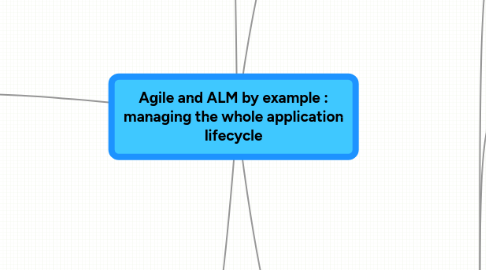
1. Project Management
1.1. Project Management
1.1.1. Project
1.1.1.1. Budgeting
1.1.1.2. Transverse Tasks
1.1.1.3. Work Breakdown Hierarchy
1.1.1.4. Epic
1.1.1.5. Product Backlog Items
1.1.2. Project Dashboard
1.1.2.1. Product Burndown by Project
1.2. Iteration Management
1.2.1. Iteration plan
1.2.1.1. Product Backlog Items...
1.2.1.2. ...according their Story Points...
1.2.1.3. ...and Velocity
1.2.2. Tasks
1.2.2.1. Tasks estimation
1.2.2.2. Completed & remaining work tracking on Tasks
1.2.3. Done Story Points
1.2.3.1. Story Points
1.2.3.2. Definition of Done
1.2.4. Iteration closing
1.2.4.1. Retrospective
1.2.4.2. Velocity update
1.2.5. Iteration Dashboard
1.2.5.1. Velocity
1.2.5.2. Iteration Burndown (with Points)
1.2.5.3. Iteration Burdown by Project (with Points)
1.2.6. Team Member Dashboard
1.2.6.1. Process auto-controls
2. ALM : from Application birth to its death, why ?
2.1. ALM phases/activities
2.1.1. Project from scratch
2.1.2. Evolutionary Project
2.1.3. Support
2.1.4. Maintenance
2.2. Dedicated team to application Vs dedicated to project
2.2.1. Collective code ownership
2.2.2. Application service homogeneity
2.2.3. Activities diversity/motivation
2.3. Processes Integration
2.3.1. Including Transverse ones
2.3.1.1. Accountability
2.3.1.2. Timesheet
2.3.2. CMMI Dev areas
2.3.2.1. Project Management
2.3.2.2. Engineering
2.3.2.3. Support
3. Support
3.1. Configuration Management
3.1.1. Documents in SharePoint Portal
3.1.2. Wiki in SharePoint Portal
3.1.3. Source Control in TFS
3.1.4. Change request tracking with Work Items
3.2. Measurement and Analysis
3.2.1. Velocity
3.2.1.1. Relative to Available Time
3.2.1.2. Production velocity
3.2.1.3. Global velocity
3.2.2. Definition of Done
3.2.3. Story Points
3.2.4. Estimated/Completed/Remaining Work
3.3. Process and Product Quality Assurance
3.3.1. Process Control
3.3.1.1. Process Control Requests
3.3.1.2. Work Items Type Integrity
3.3.2. Product Quality
3.3.2.1. Code Metrics with Sonar
3.3.2.2. Engineering practices
4. Engineering
4.1. Continuous Integration
4.1.1. Build
4.1.2. Deploy in test env
4.1.3. Tests
4.1.4. Package
4.2. Delivery
4.2.1. Release
4.2.1.1. Content
4.2.2. Product Backlog Items Delivery Workflow States
4.2.2.1. Ready for Deliver
4.2.2.2. To test in Qualification
4.2.2.3. Ready for Production
4.2.2.4. In Production
4.2.3. Versioning
4.2.3.1. Generated Build Number
4.3. Requirements - Product Backlog
4.3.1. PB Items
4.3.1.1. Defect
4.3.1.1.1. Subtyping
4.3.1.1.2. No business value
4.3.1.1.3. In Production or during Release process, not in Dev !
4.3.1.2. User Story
4.3.1.2.1. Business Value
4.3.1.2.2. Convention : "As [User] I can [do something] in order to [reach a goal] in a [user context]"
4.3.2. Epic
4.3.2.1. To be splitted in PB Items
4.3.2.2. Cannot be produced nor released
4.3.3. Product Documentation when Done
4.3.3.1. Obsolescence
4.3.3.1.1. Obsolete Workflow State
4.3.3.1.2. Replace/Replaced by link
4.3.3.2. Parent/child hierarchy
4.3.3.3. Theme
4.3.4. Story Points
4.3.5. Definition of Done
4.3.5.1. Items Workflow States
4.3.5.1.1. New
4.3.5.1.2. In progress
4.3.5.1.3. Resolved
4.3.5.1.4. Rejected
4.4. Testing
4.4.1. TDD
4.4.2. Acceptance TDD
4.4.2.1. Test Cases
4.4.2.2. Acceptance criteria
4.4.3. Tests Automation
5. Example with TFS 2010
5.1. Integrated tool...
5.1.1. Source Control
5.1.1.1. Changesets linked with Work Items
5.1.1.2. Check-in policies
5.1.2. Team Build
5.1.2.1. MSBuild
5.1.2.2. Work Items links
5.1.3. Work Items
5.1.3.1. Workflow
5.1.3.2. Fields
5.1.3.3. Links
5.1.3.4. Hierarchy
5.1.4. Reporting
5.1.4.1. Datawarehouse SQL Server
5.1.4.2. Cube SS Analysis Services
5.1.4.3. Reports SS Reporting Services
5.1.5. SharePoint Portal
5.1.6. TFS Web Access
5.2. ...easily customizable...
5.2.1. Process Templates for packaging
5.2.2. Work Item Type Definition (XML)
5.2.3. Datawarehouse extensions (SQL views...)
5.2.4. Cube extensions (dimension, measures, calculations...)
5.2.5. Custom Reports SSRS
5.2.6. Agility through easy incremental deployment for all components
5.2.7. ..."at worst" TFS API .NET
5.3. ...even if not the best for each function...
5.3.1. Source Control with Git
5.3.2. Continuous Integration with Hudson
5.4. ...with some external tools
5.4.1. Sonar with plugins
